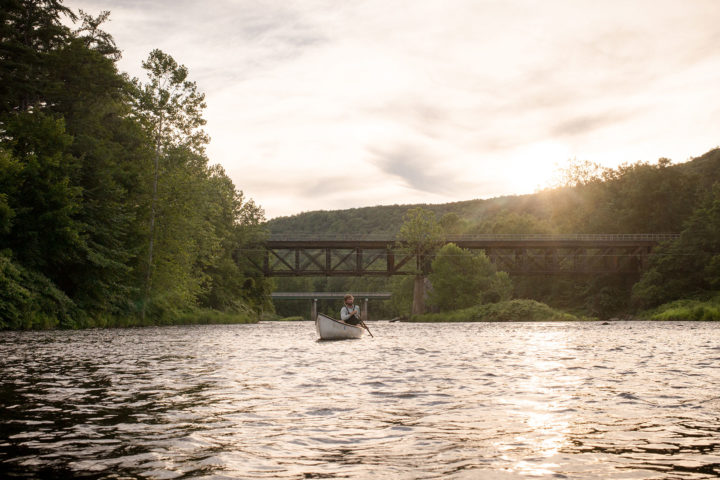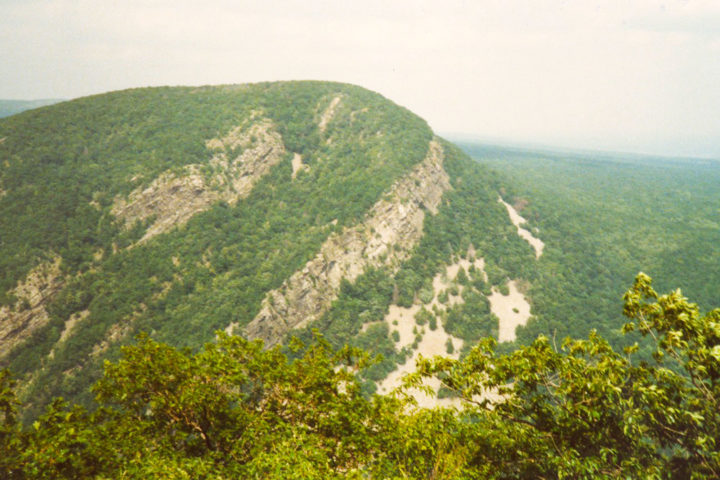How healthy stream banks improve water quality
Land to Water
Many of us have sat near a flowing stream, listening to the relaxing sounds of water tumbling over and around rocks smoothed by its motion. Have you ever stopped to consider the banks of our waterways? Are they forested with trees, lined with tall grasses, or buffeted with shrubs? Is there a marsh, farm field, road, or paved path nearby? Do the banks gently slope into the water or do they drop steeply?
These transitional areas, called riparian zones or riparian buffers, form the boundary between the stream and the surrounding landscape. The vegetation in riparian buffers, including trees, native grasses, and other low-growing plants, plays a unique role in creating habitat for land- and water-dwelling creatures and providing healthy freshwater, critical for drinking water supplies.
Nature’s Water Treatment Plants
Properly functioning riparian zones represent a small percentage of the landscape but serve as nature’s water treatment facilities, helping to improve overall water quality. The roots of trees and other plants help stabilize banks, preventing erosion or the release of dirt and other sediment into waterways.
Riparian zones also help to control, redistribute, and absorb water to help reduce flooding downstream. In addition, buffers can act as a large sponge, with plants, microbes, and soil catching runoff from nearby areas; filtering sediment, excess nutrients, and pollutants; and breaking them down before they reach the water.
Healthy Buffers Mean…
Healthy buffers provide multiple benefits to streams and wildlife. Some of the benefits landowners could see from a restored, healthy riparian zone with trees and plants are:
- Increased property value
- Reduced property loss through bank stabilization
- Improved water quality for you and your community
- Enhanced wildlife habitat
- Reduced noise from nearby roadways or properties
- Improved privacy
- Enhanced scenic views and natural beauty
Habitat and Food for Wildlife
Importantly, riparian buffers create homes and resting places for a variety of wildlife, including fish and other aquatic life, birds, and insects, as well as migration routes for birds and mammals. Overhanging or fallen vegetation creates welcoming environments by shading and cooling water, which helps to maintain higher absorbed oxygen levels necessary for plants, fish, and other aquatic animals to survive.
Debris from fallen trees such as leaves, twigs, and logs, as well as tree and plant roots, are important and necessary for a healthy stream ecosystem. Bacteria that live in the soil and among roots help break down excess nutrients from upland runoff and form the beginning of a food chain for diverse species. Larger organisms, such as insects, feed on these bacteria and become a food source for even larger animals, including fish, turtles, salamanders, and birds.
Size Matters
The larger the riparian buffer, the more benefits provided. The minimum recommended buffer size is 35 feet from stream bank into the land. However, many scientists agree that a minimum riparian zone of 100 feet up to 300 feet is more desirable.
Most fertilizers commonly used in agricultural settings contain three basic plant nutrients: nitrogen, phosphorus, and potassium. But excess nutrients can runoff into adjacent streams, causing an increase in water components that are harmful to aquatic communities and overall water quality. Riparian buffers help to remove excess nutrients by hosting plants and microbes that breakdown these components before they reach the water. According to the U.S. Environmental Protection Agency, wider buffers of 165 feet or more prevent notable amounts of nitrogen from entering a riparian zone.
Threats and Restoration
In 1981, the U.S. Fish and Wildlife Service estimated about 70% of the nation’s original, natural riparian habitats had been converted to urban or agricultural uses. In the Delaware River watershed, development, agricultural practices, and a lack of awareness among private land owners continue to threaten riparian buffers or prevent their restoration.
But through the Delaware River Watershed Initiative (DRWI) — a collaborative effort supported by the William Penn Foundation and involving 65 non-governmental organizations — that is changing. The initiative is among the country’s largest non-regulatory conservation efforts to protect and restore clean water, with groups working at an unprecedented scale to protect and restore clean water in the Delaware River watershed, the source of drinking water for 15 million people in Pennsylvania, New York, New Jersey and Delaware.
Restoration in New Jersey Through Partnership and Education
“A lot of the landscape in the New Jersey Highlands watershed was once developed for different agricultural purposes,” said Michelle DiBlasio, Watershed Restoration Coordinator for The Nature Conservancy in New Jersey. “Over the last 20-30 years, many farms have stopped operating, but the capacity is not there to restore and manage the land. That’s where we can come in with our partners to try to restore the riparian areas, to put them back to where they once were before farming,” DiBlasio added.
Cole Baldino, Upper Delaware River Manager for Trout Unlimited, said his organization and others in New Jersey take a holistic approach to riparian zone restoration. “We work closely with The Nature Conservancy, Audubon New Jersey, and other partners to see what is best for the ecosystem,” Baldino noted. Partners collaborate with landowners to come up with strategies to restore riparian buffers using native plant and tree species.
While many forests and freshwater systems in the Highlands watershed are in good condition, water quality impairments, such as excess nutrients and elevated water temperatures, exist and could worsen, according to John Parke, Stewardship Project Director for the North Region at Audubon New Jersey.
Audubon N.J. prioritizes improving water quality in the Highlands — the region provides drinking water for 5.4 million N.J. residents — while also cultivating or enhancing wildlife habitat and other biodiversity. “The region’s waterways serve as habitat for numerous wildlife species including trout and other fish, and endangered or threatened species such as long-tailed salamander, wood turtle, several dragonflies and freshwater mussels that are dependent on high water quality for their survival,” Parke said.
Different Focus, Same Goal
“We’re all working to minimize threats to waterways and wildlife by establishing vegetation, but we can’t do that work alone,” DiBlasio of The Nature Conservancy said. Each partner organization and landowner might have a different focus, whether that is to protect fish or bird habitat or improve stream bank stability. “But this allows us to cover all our bases and hopefully lead to lasting change,” she said, adding, “Our work could not get done without partners.”
Cole Baldino of Trout Unlimited mentioned he comes to the table with a “trout bias” but noted he has a little bit of personal bias for the riparian buffer restoration work. “I like it as a fisherman because hopefully I can go back and fish from these areas. Hopefully, in a couple years, it will look like no one has ever touched the stream banks.”
Take Action
Are you interested in helping to restore riparian zones through volunteering to plant trees and other vegetation? Are you a landowner in need of consultation regarding stream bank restoration? Are you concerned about regulations for riparian buffers? Contact your local officials and these organizations in your area to learn more about how you can help or how to restore a riparian zone on your property, often at no cost.
Take Action
If you live, work or play in in one of the townships below, you can take action now to help improve the health and conservation of the Delaware River.
Pennsylvania
Upper Bern
Upper Tulpehocken
Windsor
East Penn
Lower Towamensing
Lynn
Eldred
Hamilton
Middle Smithfield
Stroud
Upper Mt. Bethel
Washington
West Penn Township
New Jersey
Albany
Frankford
Hampton
Montague
Sandyston
Stillwater
Hardwick
Frankford
Hampton
Montague
Sandyston
Stillwater
Hardwick
Call or email your local officials and tell them you support clean water and the protection of local rivers and streams by requiring vegetative and forested buffers along their banks that are at least 100 feet wide.
Thank you for protecting the Delaware River to ensure everyone has safe and fun outdoor experiences!
Discover More

Take Action
Protect the Delaware River Watershed
Take action to protect clean water and recreation opportunities along the Delaware River and beyond.

A Unity of Land and Water
Delaware Water Gap
Learn about the unique legacy of Delaware Water Gap, a hub of history, recreation, and conservation.

Hear Their Stories
The River’s Voices
Interviews with People Who Live, Work, And Play in the Delaware River and Its Surrounding Lands.
